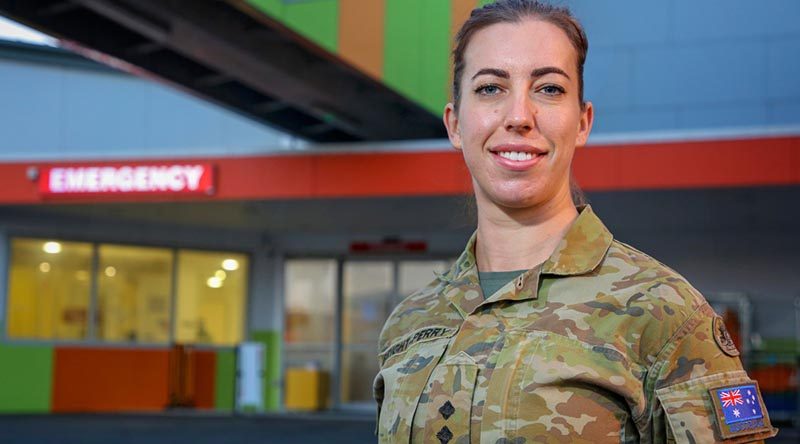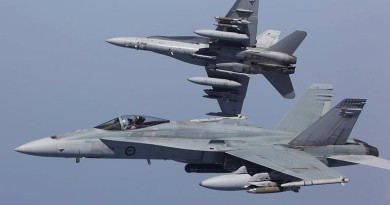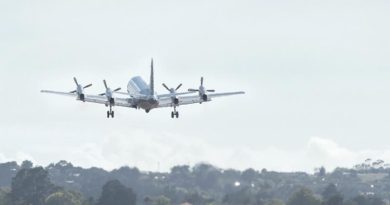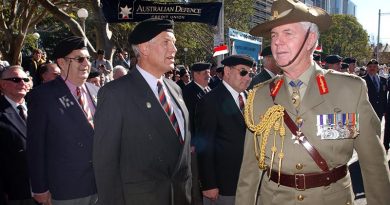New career flexibility for nursing officers a win for Defence
Share the post "New career flexibility for nursing officers a win for Defence"

The future holds more flexibility for nursing officers, as the total workforce model lets them move in and out of full-time Army to meet personal and professional goals.
FILE PHOTO: Australian Army nursing officer Lieutenant Celie Bright-Perry from 2nd General Health Battalion, outside the emergency department of the North West Regional Hospital in Burnie Tasmania during Operation COVID-19 Assist. Photo by Corporal Nicci Freeman. Story by Sergeant Sebastian Beurich.
This flexibility, along with increasing recognition of different nursing specialities, will be the future recruitment drawcard for RAANC, according to career managers and nursing officers Major John Martin and Captain Madeline Secco.
“You can do a role in Army as SERCAT 7, then transfer to SERCAT 6 or 5 for a year or two while you undertake a contract with a hospital, then bring those skills back to Army in another role,” Captain Secco said.
“We’ve seen a rising number of people using that system over the past two years, ensuring that as clinicians and officers, they’re getting the best experience and developing themselves for whatever the future holds.”
While part-time nursing officers remain up to date on clinical skills through civilian employment, fulltimers have the opportunity to do placements at hospitals.
“We do this to keep our skills current and see a broader population and presentations than just the military setting, so that when we’re in new situations, we’ve seen a breadth of disease and illnesses across age groups,” Captain Secco said.
There are three recruitment streams for nurses – the undergraduate scheme, direct-entry officer and service transfer.
Undergraduate candidates must do the first year of an eligible degree, while direct-entry officers must have their bachelor of nursing, registration and two years’ clinical experience.
All Army nurses complete the Specialist Service Officer course, the Logistics Officer Basic Course and the ADF Extended Practice Nursing course before they’re considered ‘fully employable in a military setting’.
“Potential nursing officers undertake a selection process similar to the other corps.
“We are looking for people who are motivated and looking to serve as nurses in support of ADF personnel,” Major Martin said.
“Being an Army nursing officer is unlike any other role.
“You are expected to be a clinician and a leader all in support of the nation’s interests, be they overseas or within Australia.
“Being able to serve in support of ADF personnel and the Australian community is truly a humbling experience.”
Captain Secco said that regardless of SERCAT or avenue of entry, appointment as a nursing officer was personally and professionally rewarding.
“In-service transfers should have commenced their studies at a minimum, but we’d also be looking at recommendations from their chain of command based on how they perform in their current role,” she said.
“Different specialities come through the same process, but we definitely take their experience and tertiary qualifications into consideration, as they all bring something different to Army.”
Work is being done to recognise different specialities, how to employ them and how they stay current within the clinical framework.
Major Martin said it was an exciting time for nursing officers.
“We are further developing clinical scopes of practice and how they can be attributed to a nursing-officer’s specialisation and clinical progression.
“A nursing officer has to develop as a clinician and as a leader.
“Defining specialisations and investigating the employment of high-end specialists, such as nurse practitioners is exciting.”
Find more information about nursing officer recruitment on the DFR website.
Story courtesy ARMY newspaper
.
.
.
.
.
.

.
.
Share the post "New career flexibility for nursing officers a win for Defence"





